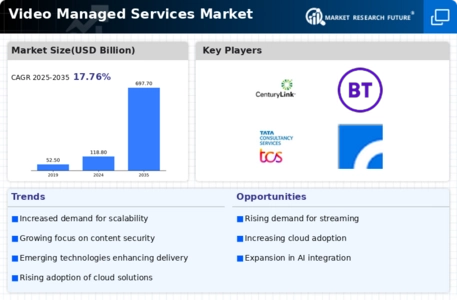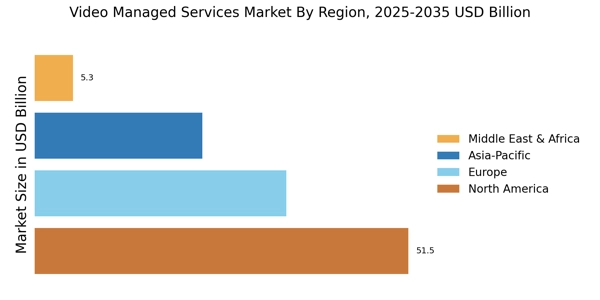Rising Demand for Video Content
The Video Managed Services Market experiences a notable surge in demand for video content across various sectors, including entertainment, education, and corporate communications. As organizations increasingly recognize the value of video as a communication tool, the need for managed services that can efficiently handle video production, distribution, and analytics becomes paramount. Recent data indicates that video content consumption has risen significantly, with projections suggesting that by 2025, video will account for over 80% of all internet traffic. This trend compels businesses to seek specialized services that can ensure high-quality video delivery and management, thereby driving growth in the Video Managed Services Market.
Growing Importance of Data Analytics
Data analytics has emerged as a pivotal driver in the Video Managed Services Market. Organizations are increasingly leveraging analytics to gain insights into viewer behavior, content performance, and engagement metrics. This data-driven approach allows businesses to optimize their video strategies, tailoring content to meet audience preferences and enhancing overall effectiveness. The market for video analytics is projected to grow substantially, with estimates suggesting a compound annual growth rate of over 20% in the coming years. Consequently, the demand for managed services that provide robust analytics capabilities is likely to rise, further fueling the expansion of the Video Managed Services Market.
Technological Advancements in Streaming
Technological advancements play a crucial role in shaping the Video Managed Services Market. Innovations in streaming technology, such as improved compression algorithms and adaptive bitrate streaming, enhance the quality and reliability of video delivery. These advancements enable service providers to offer seamless viewing experiences, which is increasingly important as consumer expectations rise. Furthermore, the integration of 5G technology is anticipated to revolutionize video streaming capabilities, allowing for faster and more efficient content delivery. As a result, businesses are likely to invest in managed services that leverage these technologies to stay competitive, thus propelling the growth of the Video Managed Services Market.
Emphasis on Cost Efficiency and Scalability
Cost efficiency and scalability are critical considerations for businesses operating in the Video Managed Services Market. Organizations are increasingly seeking managed services that can provide flexible pricing models and scalable solutions to accommodate fluctuating video demands. This emphasis on cost-effectiveness is particularly relevant as companies aim to optimize their budgets while maintaining high-quality video production and distribution. Recent trends indicate that businesses are more inclined to outsource video management to specialized providers, allowing them to focus on core activities. As a result, the demand for scalable and cost-efficient managed services is likely to drive growth in the Video Managed Services Market.
Shift Towards Remote Work and Collaboration
The shift towards remote work and collaboration has significantly influenced the Video Managed Services Market. As organizations adapt to new work environments, the need for effective communication tools, including video conferencing and virtual collaboration platforms, has surged. This trend has led to an increased reliance on managed services that can facilitate high-quality video interactions, ensuring that teams remain connected and productive regardless of their physical locations. Market data suggests that the remote work trend is likely to persist, with many companies adopting hybrid work models. This ongoing transformation is expected to sustain demand for video managed services, thereby contributing to the growth of the Video Managed Services Market.


















Leave a Comment